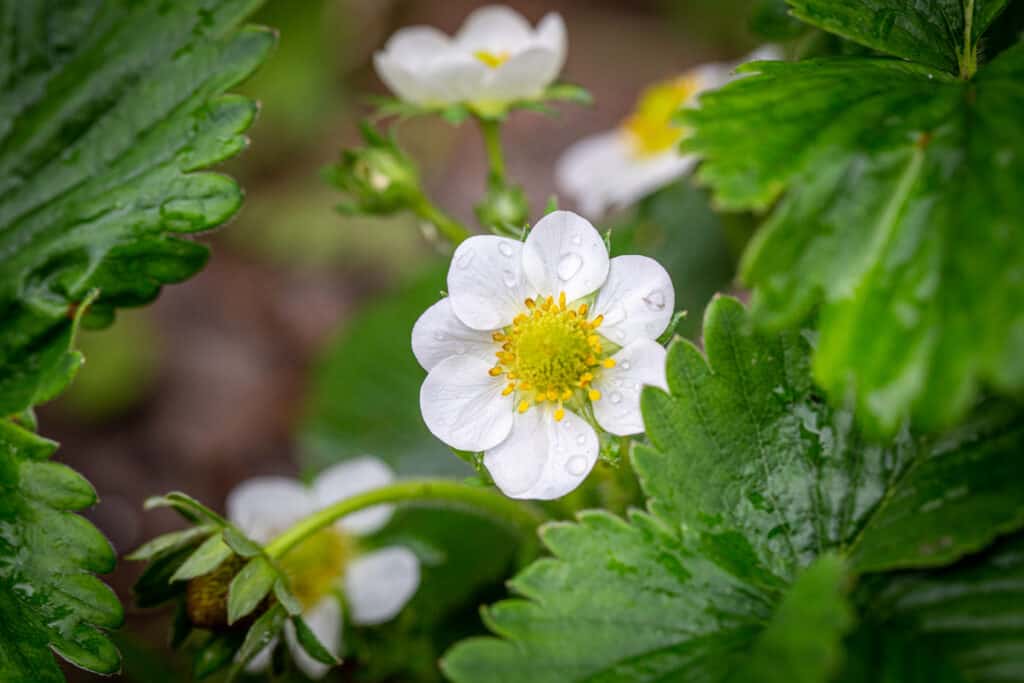Strawberries are an excellent fruit to enjoy during the summer. Not only are they delicious and juicy summer fruits, but during spring, you can also pick them at local strawberry farms. Strawberry season though ranges depending on your location. Have you ever seen a strawberry plant? Strawberry plants are beautiful and spread quickly. They typically develop bright white flowers that soon produce red fruits. Although most people grow strawberries outdoors and in the ground, you aren’t limited to this option. Strawberries can also be grown in containers of all sizes, in hydroponics systems, and indoors. Follow along to discover how to grow strawberries indoors in five quick and easy steps.
About Strawberries
Before we dive into the step-by-step process of how to grow strawberries, we should learn more about the plant. Strawberry plants are flowering plants in the rose family. There are at least 20 different species throughout the world. The scientific name for strawberry is Fragaria.
Possibly the most commonly grown and distributed strawberry species is the garden strawberry, the Fragaria × ananassa. This hybrid species was first cultivated in the 18th century. These plants are known for their beautiful and delicate white flowers and vibrant red fruits. The red fruits are juicy, sweet, and aromatic.
Strawberries are mainly used in culinary. You can eat them raw, or cook them to use in jam. Strawberry flavoring is also common in candies, ice creams, drinks, and more. Old wild strawberry species though were used as medicine. This fruit was used for its medicinal properties in ancient Rome as recorded in ancient Roman literature.

One of the most commonly grown strawberry varieties in the world is the garden strawberry.
©iStock.com/MariaUspenskaya
Can You Grow Strawberries Indoors?
There are many ways you can grow strawberries indoors, however, this plant can be tricky. Strawberries need specific light and temperature requirements. Not enough light or too much light can stunt the plant’s growth or delay the flowering process.
One of the easiest methods of growing strawberries inside is to use a small hydroponics system. You can buy it or create one. There are small kits that fit in small spaces, like on your kitchen counter. These systems automatically turn on and off LED lights, so you don’t have to worry about forgetting. Plant food and nutrients though are necessary.
You don’t have to grow strawberries in a hydroponics system though. You can also grow these delicious fruits in containers with soil, as long as you use grow lights. Although some windows provide bright light, strawberry plants are picky and need at least 6 hours of direct sunlight or 12 to 18 hours of LED light. Thankfully, you can usually schedule grow lights to turn on and off. Either way, growing this delicious fruit, doesn’t have to be a dream.

You can grow strawberries indoors with LED grow lights.
How to Grow Strawberries Indoors
Strawberries take about 60 to 90 days to fruit from seed, however, the time depends on the variety and your environment. Indoors, it may take longer as you have to mimic your plant’s desired natural habitat. Using these 5 steps, you can grow strawberries indoors easily. However, many methods work.

You can grow strawberries indoors using containers and grow lights.
©iStock.com/nicksus
Step 1: Choose the Right Variety
The first step in how to grow strawberries indoors is to choose the right strawberry variety and cultivar. There are many to choose from, some designed for small spaces and indoor conditions. Some of the most popular strawberry cultivars include Alice, Alpine Yellow Wonder, Evie, Flavorfest, Honey, and the Grande Berried Treasure Red. Always read the instructions before choosing and planting a strawberry cultivar. Not all bear fruit in the same season.
Step 2: Set Up the Container
Next, after choosing the right variety for you, you’ll need to set up your strawberry plant’s container, grow light, and spot. Strawberry plants aren’t picky. They don’t need a massive amount of space. You can grow these lovely flowering plants in hanging baskets, stackable containers, grow bags, window boxes, and more. If you are only growing one strawberry plant, you might be able to get away with a 6 to 8-inch deep container. However, if you wish to grow more than one plant, it’s best to choose a long container where you can space them out. Strawberries are also quick spreaders and will produce runners. Your container’s shape doesn’t matter much as long as it has proper drainage holes at the bottom.
So, what kind of soil is best for strawberry plants? Strawberries need well-draining, nutrient soil, that is slightly loose. It’s best to use soil that is organically rich but also doesn’t remain wet. Too much water attracts aphids and increases humidity, especially indoors.
Growing strawberries inside requires more than just the right soil and container, you also need powerful grow lights. Grow lights vary in size and intensity. We recommend using a long and wide grow light, instead of a small attachable light. If possible, set up a metal rack and secure the grow light to the bottom of a shelf. Place the strawberry container on the shelf underneath the grow light. Schedule the lights to turn on and off automatically. Strawberries need at least 12 to 16 hours of artificial light when grown indoors.
Step 3: Plant the Seed and Water
Once you have the right soil and container, you can plant the seed. Sowing the seeds in the soil is easy. You don’t need to germinate the seeds before sowing them in the container. Instead, to mimic winter-like conditions, place the seeds in an air-tight plastic bag in the refrigerator for a few weeks. Make sure no water gets inside the bag. Afterward, take a few strawberry seeds and spread them on the soil’s surface. You don’t need to cover them with soil. Water evenly and leave the seeds and soil moist. The seeds can take anywhere from 7 to 42 days to germinate. Water your strawberry plant daily as it grows. Plants in containers generally need more water. Your plants will need more water during the fruit-bearing season.
Step 4: Fertilize and Prune
Fertilization isn’t always necessary. However, you can fertilize your strawberry plants with a 10-10-10 fertilizer during spring and fall. Don’t fertilize your plant during winter as it needs to remain dormant.
Pruning is essential if you want to keep your plant healthy. If you notice mildew or fungus on your plant’s leaves, trim the leaves and affected flowers with sterile scissors or pruners. If not, the diseases can spread. If you notice mildew, you can use fungus to control the spread. However, the use of sulfur when temperatures are above 80°F can burn your strawberry plant. It’s also important to prune your plant if it produces flowers too early in the season. This is also usually a sign of stress.
Step 5: Harvest and Enjoy
Strawberries take weeks to ripen enough to harvest from the first sign of a blossom. If you pick them too early, they won’t be as sweet or juicy. It’s best to harvest strawberries every few days. Use scissors to cut strawberries by the stem. If you yank hard, you can damage your plant.
Common Strawberry Growing Problems
Strawberries aren’t the easiest fruits to grow, but they are worth the work. One of the most common problems is overwatering. Overwatering any plant can attract pests and lead to mold and other issues. Strawberries need a lot of watering when they are producing flowers and fruits, however, too much water can lead to root rot, which kills the plant slowly. Sometimes, it’s best to water your plant in little amounts. Underwatering strawberry plants is an easy fix. A way to prevent overwatering and soggy roots is to use well-draining soil and containers with drainage holes.
Apart from watering issues, strawberries also sometimes develop powdery mildew. Usually, you can see the white powdery mildew before it spreads to the fruit. A sign of mildew, apart from white powder, is curling leaves. Your plant’s leaves may also turn purple or red. This is very common in humid places. It’s not always preventable, but to lower your chances, you can use a fan to provide air circulation if your home is too humid.
If your strawberry plant is growing slowly, it might be because of fusarium wilt. Fusarium wilt is a fungal disease that causes leaves to wilt and curl and slows growth. It spreads through contaminated soil. This is why it’s important to always use new soil and sterilize old containers.
Thank you for reading! Have some feedback for us? Contact the AZ Animals editorial team.








